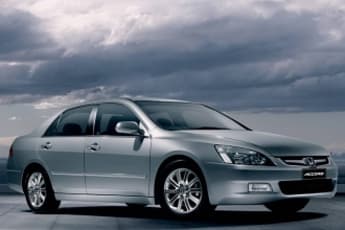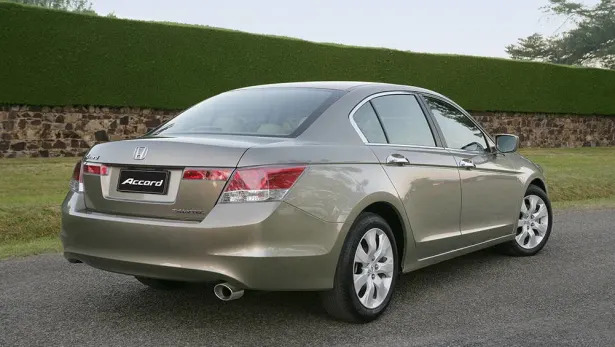Your cart is currently empty!
2008 Honda Accord VTi
Original price was: $4,500.00.$2,990.00Current price is: $2,990.00.
Honda Accord 2008: VTi
| Engine Type | Inline 4, 2.4L |
|---|---|
| Fuel Type | Unleaded Petrol |
| Fuel Efficiency | 9.3L/100km (combined) |
| Seating | 5 |
| Price From | $4,070 – $6,050 |
Description
More than 10 million cars have been sold globally and for the past few years two models, the Accord and Accord Euro, have been available in Australia.
The eighth-generation Accord has just arrived in showrooms and the replacement Euro will be unveiled at the Geneva Motor Show, which opens in Switzerland.
Like our Australian-built Toyota Camry, the Thai-built Accord comes with a choice of four-cylinder or V6 engines.
But Honda does not pretend its V6 is anything but an Accord, whereas Toyota has tried to separate the Camry and its V6 model by calling the latter the Aurion.

In the Accord, the 2.4-litre i-VTEC four-cylinder is reserved for the entry VTi and VTi Luxury. It develops 8kW and 4Nm more than the old car.
The V6 has grown from 3.0-litres to 3.5-litres, now develops 202kW/339Nm and has variable cylinder management. This means the car can run on six, four or three cylinders, depending on driving conditions, and saves about 8 per cent in fuel over a V6 with cylinder deactivation.
The system allows the 3.5-litre V6 to deliver 10 litres for 100km. The 2.4-litre manages 8.8 litres for 100km on the combined cycle.
Both the four and V6 have five-speed automatic transmissions driving the front wheels.
The sedan has grown slightly, being 115mm longer, 25mm wider and 20mm higher than the previous Accord. The wheelbase has grown
to 2800mm, 60mm more than the previous car.
Underpinning the car is the same front double-wishbone suspension, now with anti-dive geometry, and the rear gets a new multi-link design built into a stiffer body structure that gives the rear suspension 40 per cent better lateral rigidity.
The bigger body translates into a roomier cabin, and torsional rigidity is up 20 per cent thanks to the use of high-tensile steel.
Because the car is sourced from Thailand, which enjoys free-trade status with Australia, Accord pricing is sharp.
The 2.4-litre VTi is $29,990, the VT-i Luxury $36,490, the V6 $38,490 and V6 Luxury $46,990.
Standard equipment includes dual-zone climate control, height and reach-adjustable steering wheel, five-speed automatic transmission, active front headrests, anti-skid brakes, dual front and side airbags, stability control, traction control and electronic brake assist.
Curtain airbags are standard on the 2.4 VT-i Luxury, V6 and V6 Luxury, along with electric driver’s seat.
The Luxury models get heated front seats, leather upholstery and a leather-wrapped gear lever.
The V6 also gets active noise control, and the V6 Luxury adds curtain airbags, a trip computer, navigation system and reversing camera.
Honda Australia director Lindsay Smalley says the company expects to sell 800 a month. The entry model should account for 60 per cent of sales.
He says there are no plans for an Accord diesel in the short term. Honda’s philosophy is hybrid for its smaller cars and diesel for its larger ones.
“We are watching the rise of consumer interest in diesel and studying it,” Smalley says.
“The issue is that with a diesel we would need an automatic transmission for our markets.”
On the road
I am not a big fan of gimmicks, but the active noise control and cylinder deactivation on the 3.0-litre Luxury works a treat.
The noise control, first seen on the Legend, removes the low-frequency peripheral noise from the cabin, delivering a more serene ambience.
The system uses two microphones, one in the overhead console and the other on the rear parcel shelf, to pick up low-end drivetrain noise entering the cabin.
The signal is sent to an electronic processor which, in layman’s terms, helps cancel the original noise signal.
Then there’s the sophisticated variable cylinder management system on the 3.5-litre V6, which deactivates cylinders depending on the driving conditions.
It allows the engine to operate on six, four or three cylinders, improving fuel economy.
Honda quotes a fuel figure of 10 litres for 100km for the V6, which sneaks under its rivals, Holden VE Calais, current-model Ford Fairmont Ghia and Toyota Aurion V6.
The variable cylinder management operates almost seamlessly and most drivers will be unaware which cylinders are not working.
Only the eco-green dashboard light tells you that the engine is operating in its most economical mode.
With 202kW on tap from the 3.5-litre V6, the Accord Luxury does a reasonable job of getting the 1650kg sedan moving. There’s enough mid-range response for overtaking and the engine will go up to 7000 revs without complaint.
The 2.4-litre four-cylinder engine in the base car lacks the crisp power delivery of the V6, but with 133kW on hand it does a good job of moving the metal in a smooth manner.
Other areas that have improved over the old car are ride and handling. The previous Accord, let’s be blunt, was a softy. The new car is more precise.
It does not lose its composure over rougher roads and the suspension is tuned better.
But the steering remains dull and over-assisted at speeds above 60km/h. More feedback would be welcome.
The bonus with Hondas is they have impeccable build quality. The Accord is no different, despite being built in Thailand.
We also love the fact Honda has included a full-size spare but the boot floor design does unnecessarily intrude into available space.










Reviews
There are no reviews yet.